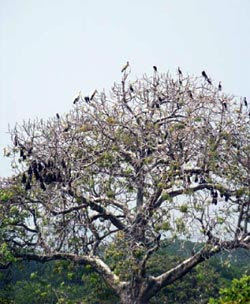 As the name suggests, these small islands offer a wide range of attractions, from tourism to marine life.
As the name suggests, these small islands offer a wide range of attractions, from tourism to marine life.Pulau Seribu, the "Thousand Islands", extend northward from Jakarta in Jakarta Bay. Actually numbering only around 140, they nevertheless offer many points of interest, particularly maritime tourism with white sand beaches, calm waters, and underwater coral formations. Most of the islands lie within the Maritime National Park; only 37 islands are allowed to be used for commercial purposes.
Pulau Rambut ("Hair Island"), also known as Bird Kingdom Island, is one of the closest to the mainland of Java; you can get there in just an hour from Muara Angke harbor. The status of this uninhabited 45-hectare island has recently been upgraded from nature preserve to wildlife preserve, because of the rising level of damage within and around the Pulau Rambut area.
In addition to coastal forest, mangrove forest and mixed secondary forest, the Pulau Rambut Wildlife Preserve is also home to 25 species of water birds, among the 61 bird species found there. These include pecuk ular (oriental darter), kuntul (egret), cangak (heron), bangau (stork), and ibis.
A 20-meter bird observation tower stands near the middle of the island. As well as birds, reptiles also live on the island, including monitor lizards, pythons, and geckos. The only mammals found here are fruit bats. There's also a great diversity of plant life, with tree species including pidada, mangrove, key lime, and banyan.
Also found on this island is a bird species that migrates from Australia, the milky stork (bangau bluwok, Mycteria cinerea), which arrives here in January and leaves in August. Pulau Rambut is the only breeding ground for milky storks in Java.
Not far from Pulau Rambut lies Pulau Onrust, near Pulau Cipir and Pulau Kelor. Onrust contains the remains of buildings, including a shipyard, built by the Dutch during the 18th century. Construction at Onrust was started in 1618 by Governor General Jan Pieterszoon Coen. In addition to a pier, he built a shipyard with a windmill to operate the saws.

During the Dutch colonial period, this island was very busy as a port of call for ships of the Dutch East Indies Company (Verenidge Oost Indische Compagnie, VOC), hence the name Onrust, which means "Never Rests".
Beyond Onrust, another interesting island to visit is Pulau Kotok. The Pulau Kotok Tourist Resort is a good example of a tropical atoll, with the original vegetation, clear seas, and colorful coral formations, making it a popular destination for divers. This island is also a rescue and translocation center for protected wildlife species including the white-bellied sea eagle (elang laut perut putih, Haliaeetus leucogaster) and the brahminy kite (elang bondol, Haliaster indus), the mascot of the province of DKI Jakarta.
Further out, around three hours from Muara Angke Harbor, lies Pulau Pramuka. This island houses the Kepulauan Seribu National Park and the Rare Marine Biota Hatchery and Laboratory, where you can watch and learn about the cultivation of rare marine species.
Pulau Pramuka is a sea-turtle dissemination area for the island of Java, particularly Hawksbill turtles (penyu sisik). Twenty years ago, most of the sandy beaches on 108 of the islands provided places where turtles laid their eggs. With the steady increase in human activity and habitation, now the turtles only visit a few islands to lay their eggs, among them Pulau Peteloran Timur, Pulau Peteloran Barat, Pulau Penjaliran Barat and Pulau Penjaliran Timur.
 The Hawksbill turtle preservation activities at Pulau Pramuka involve collecting the turtle eggs from the beach where they are naturally laid at Pulau Peteloran. The eggs are then taken to Pulau Pramuka, where they are kept in semi-natural incubation by burying them 40-50 cm deep. The eggs hatch after 40 to 60 days. This turtle conservation activity has made the Thousand Islands a destination for marine conservation and education tourism.
The Hawksbill turtle preservation activities at Pulau Pramuka involve collecting the turtle eggs from the beach where they are naturally laid at Pulau Peteloran. The eggs are then taken to Pulau Pramuka, where they are kept in semi-natural incubation by burying them 40-50 cm deep. The eggs hatch after 40 to 60 days. This turtle conservation activity has made the Thousand Islands a destination for marine conservation and education tourism.In addition to Hawksbill turtle conservation, other activities on the island include planting of coastal plants – butun, mangrove, and sea grass – and coral reef preservation. The butun trees are being planted in an effort to raise awareness of the importance of coastal forests on small islands. Mangrove planting is done using the Spaced Cluster method, the nationally-approved method for planting mangroves on small islands using coral sand as the medium.
The fabulous underwater panoramas and exoticism of Kepulauan Seribu offer you an action-packed weekend of swimming, snorkeling and diving – a delightful and unforgettable experience.
Text by Virgina Veryastuti Photos by Ati Kurnia From Garuda Inflight Magazine










0 komentar:
Post a Comment
if you like it or have any questions or responses to this article. please comment here..!!